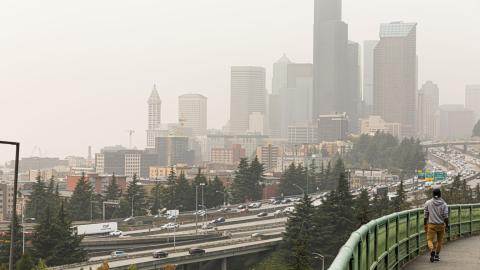Babies born today will face unprecedented health risks and life-long health consequences from rising temperatures, according to new research published Wednesday from The Lancet.
The Lancet Countdown on Health and Climate Change is a comprehensive yearly analysis tracking the impact of climate change on human health across 41 indicators. The report also projects the health benefits that would come from meeting the Paris Agreement climate targets and the health harms of business as usual.
The project is a collaboration of more than 100 experts from 35 global institutions, including the World Health Organization, World Bank, University College London and Tsinghua University. This year, Dr. Jeremy Hess, DEOHS professor, authored the U.S. policy brief and contributed to the report.
“We know that air pollution from fossil fuels has already damaged the health of generations of Americans,” said Hess, who is also associate professor of emergency medicine and global health at the University of Washington and author of the 2019 Lancet Countdown global report and US policy brief.
“It’s unnecessary and unacceptable, and we can do better. This report shows how polluting as usual harms our kids and spreads these harms on a global scale.”

The report offers an assessment of global impacts. Here are some key findings from the US policy brief:
- In 2016, there were 64,200 premature deaths in the US due to ambient PM2.5 air pollution. Roughly 8,600 of those deaths were due to coal combustion.
- Outdoor workers are increasingly exposed to life-threatening heat in the US, and urgent action is needed to protect them from further harm.
- American workers, especially in agriculture and industry, lost nearly 1.1 billion potential labor hours between 2000-2018 and 64.7 million potential hours in 2018 alone from extreme heat.
- Southern US states lost 15% to 20% of possible daylight work hours for heavy labor (e.g., agriculture and construction) in direct sun due to heat exposure during the hottest month in 2018 (July). Texas, Louisiana, Mississippi, Alabama, Georgia and Florida were particularly impacted.
- Older adults age 65 and above are especially vulnerable to extreme heat. In 2011, 22.3 million additional heat wave exposure events for older adults occurred (with one exposure event being one heatwave experienced by one person 65 years and older) above the 1986-2005 average baseline. In 2016, 11.6 million more exposure events occurred compared to the baseline, followed by 3.7 million more than the baseline in 2017 and 3.1 million more than the baseline in 2018.




